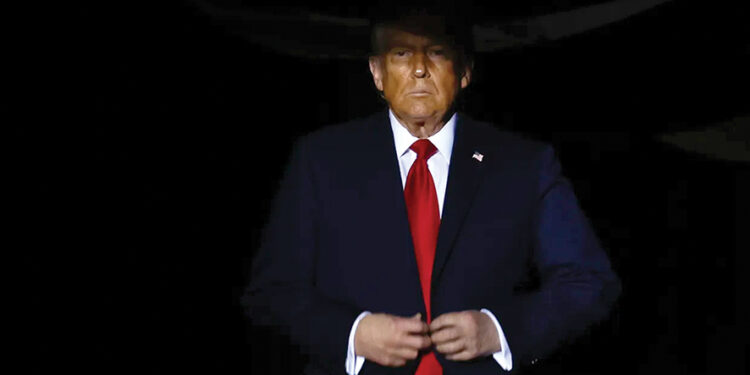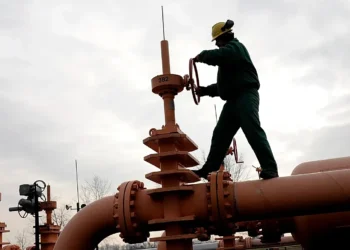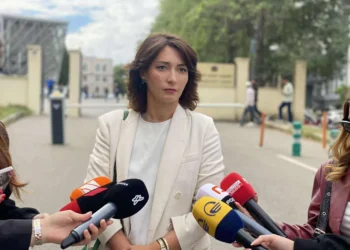US Vice President JD Vance announced on April 23 that Washington has put forward a “very explicit proposal” for a peace agreement between Russia and Ukraine, reiterating that the United States may withdraw from the peace process if both parties refuse to engage.
Speaking to reporters during a visit to India, Vance emphasized that the moment has come for Kyiv and Moscow “to either say yes, or for the United States to walk away from this process.”
“We’ve engaged in an extraordinary amount of diplomacy and on-the-ground efforts,” he said. “We’ve made a real effort to understand both Ukrainian and Russian perspectives. I believe we’ve crafted a very fair proposal.”
Vance stated that the time had come to take “if not the final step, then one of the final steps,” urging all sides to agree to end hostilities, freeze territorial lines “somewhere close to where they currently are,” and work toward a long-term diplomatic solution.
He also acknowledged that any agreement would require both sides to relinquish control of certain territories. While future borders may not align precisely with the present front lines, he said, he underscored the urgent need to halt the fighting and establish a ceasefire.
In response to Vance’s remarks, a spokesperson for the UK Prime Minister’s Office told AFP: “We support US-led efforts to bring about a lasting end to the war. That is what everyone wants. Ultimately, the decision must rest with Ukraine.”
These comments follow reports suggesting that the US is prepared to recognize Russia’s de jure control of Crimea and its de facto authority over occupied areas in Donetsk, Luhansk, Zaporizhzhia, and Kherson regions, as part of a proposed settlement.
Moscow occupies roughly 20% of Ukraine’s sovereign territory. This includes Crimea and parts of the Donbas region occupied in 2014, and additional territories taken after the start of the full-scale war in 2022.
President Volodymyr Zelensky has rejected the possibility of recognizing Russian hold over Crimea.
US President Donald Trump has said his country will abandon the ceasefire effort in the coming days unless progress is made.
Earlier, a source close to French President Emmanuel Macron told AFP that “respect for Ukraine’s territorial integrity and its European aspirations are very strong demands of the Europeans.”
The source added that while French, British, and German officials were meeting with American and Ukrainian envoys in London for ceasefire talks, “the objective remains to build a common approach that the United States could present to the Russians.”
Ukraine insists on unconditional ceasefire at London peace talks
A Ukrainian delegation met with European officials and US Special Envoy General Keith Kellogg in London on April 23 to continue discussions on a potential peace process.
“During our meeting with US Special Envoy General Keith Kellogg, we had a constructive exchange of views on the path to peace,” Ukrainian Foreign Minister Andrii Sybiha announced on X. “Ukraine wants the war to end more than anyone else in the world. We are committed to working together to achieve this goal.”
The London gathering, initially planned as a high-level ministerial summit involving the US, UK, Germany, France, and Ukraine, was notably scaled down after US Secretary of State Marco Rubio and US Special Envoy Steve Witkoff declined to attend.
Reuters reported that Rubio withdrew from the meeting following Ukraine’s submission of a document to European partners on April 22, in which it declared it would not engage in territorial negotiations until Russia agrees to a “full and unconditional ceasefire.”
Following the talks, Andriy Yermak, head of Ukraine’s Presidential Office, reiterated Kyiv’s stance: “An immediate, complete, and unconditional ceasefire should be the first step toward initiating negotiations for a just and lasting peace.”
Yermak also stressed that Ukraine would stand firm on its “principled positions,” which are rooted in national sovereignty and territorial integrity.
Despite the absence of Rubio and Witkoff, the UK Foreign Ministry reported that “significant progress was made on reaching a common position,” and said all parties reaffirmed their support for US President Donald Trump’s stated commitment to achieving a just peace.
The London talks followed a summit in Paris on April 17, where senior Trump administration officials presented a controversial peace proposal to Ukrainian and European representatives. The plan reportedly includes US recognition of Russia’s 2014 annexation of Crimea and a prohibition on Ukraine joining NATO—two major demands made by the Kremlin.
Trump says ‘nobody is asking’ Ukraine to recognize Crimea as Russian
President Donald Trump asserted on April 23 via his social media platform, Truth Social, that the United States is not pressuring Ukraine to recognize Crimea as Russian territory, following widespread reports that a proposed US peace deal would include formal recognition of Moscow’s annexation.
“Nobody is asking President Zelensky to recognize Crimea as Russian territory,” Trump wrote. “But if he wants Crimea, why didn’t they fight for it eleven years ago when it was handed over to Russia without a shot being fired?”
Trump’s remarks came just one day after Ukrainian President Volodymyr Zelensky firmly rejected the possibility of recognizing Russia’s control of Crimea, calling the issue non-negotiable.
“There is nothing to talk about. This violates our Constitution. This is our territory—the territory of the people of Ukraine,” Zelensky said during an April 22 press briefing in Kyiv.
In response, Trump criticized Zelensky’s stance, calling it “harmful to the peace negotiations with Russia” and claiming Crimea “was lost years ago under the auspices of President Barack Hussein Obama” and “is not even a point of discussion.”
However, Trump’s claim that Crimea was annexed without force is demonstrably false. In 2014, armed Russian troops in unmarked uniforms occupied Ukrainian government buildings and military installations in Crimea. One Ukrainian soldier was killed during the seizure, and dozens more were detained or assaulted. The annexation, widely condemned by the international community, was a clear violation of international law.
Trump further argued that Russia had longstanding military interests in the region, noting the presence of major Russian submarine bases in Crimea prior to the annexation. He accused Zelensky of using inflammatory rhetoric that hampers diplomatic progress.
“He can have peace, or he can fight for another three years before losing the whole country,” Trump warned. “I have nothing to do with Russia, but have much to do with wanting to save, on average, five thousand Russian and Ukrainian soldiers a week, who are dying for no reason whatsoever.”
Despite criticizing Russia’s refusal to de-escalate the conflict, Trump has thus far avoided taking significant punitive measures against Moscow, including major sanctions.
Ukraine strikes Russian drone production facility over 1,000 kilometers from its border
Ukraine’s military announced on April 23 that it conducted a long-range strike on a Russian facility producing combat drones, located more than 1,000 kilometers (621 miles) from Ukraine’s border.
Independent news outlet Astra reported earlier in the day that a Ukrainian drone had targeted the Alabuga Special Economic Zone, sharing footage allegedly showing a drone being shot down.
Russia’s Defense Ministry confirmed that its air defenses intercepted a Ukrainian “airplane-type” drone in Tatarstan at approximately 12:20 pm local time, but did not provide further details or mention Alabuga specifically.
According to Ukraine’s General Staff, the strike was carried out by the country’s Unmanned Systems Forces in coordination with other branches of the military. The targeted facility, located in Russia’s Republic of Tatarstan, reportedly manufactures up to 300 Iranian-designed Shahed drones and their Russian variants, known as Gerans, each day. These drones are frequently used by Russia in attacks on Ukrainian cities and infrastructure.
The strike marks one of Ukraine’s deepest incursions into Russian territory since the full-scale invasion began in 2022. Ukraine first hit targets over 1,000 kilometers away last year, including a strike 1,800 kilometers (1,118 miles) from the border in Russia’s Murmansk Oblast.
Ukraine’s General Staff confirmed “hits and explosions in the target area,” though the full extent of the damage is still being assessed.
“The strike is a justified response against a strategic military site used to support Russia’s aggression and terror against Ukraine and Ukrainian civilians,” the statement read.
According to Andrii Kovalenko, an official with Ukraine’s National Security and Defense Council, over 6,000 Shahed-type drones were produced at the Alabuga facility last year, alongside thousands of decoy drones designed to overwhelm Ukrainian air defenses.
Russian forces continue to launch hundreds of drones on an almost nightly basis, targeting civilian areas and critical infrastructure across Ukraine. These attacks have intensified in recent months, as Moscow continues to reject a US-backed proposal for a 30-day ceasefire, which Kyiv insists must include a halt to strikes on civilian infrastructure.
Volodymyr Zelensky has called for a temporary freeze on long-range drone and missile attacks, but Kremlin officials have dismissed the idea.
Russian Attack on Kyiv on Thursday Kills 9
Russian forces launched a major missile and drone attack on Kyiv early Thursday, killing at least nine people in the city, and injuring more than 60, the Ukrainian authorities said, in the deadliest strike on the Ukrainian capital since last summer. Explosions could be heard throughout the night; clouds of brown smoke rose over the city as the sun came up. One missile hit a two-story building with eight apartments where emergency workers hunted for survivors Thursday morning.
Compiled by Ana Dumbadze














